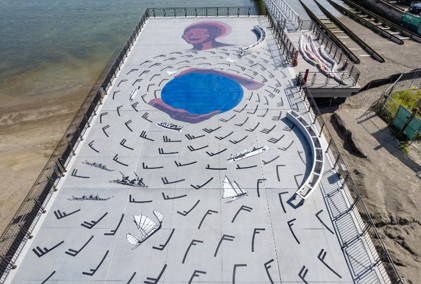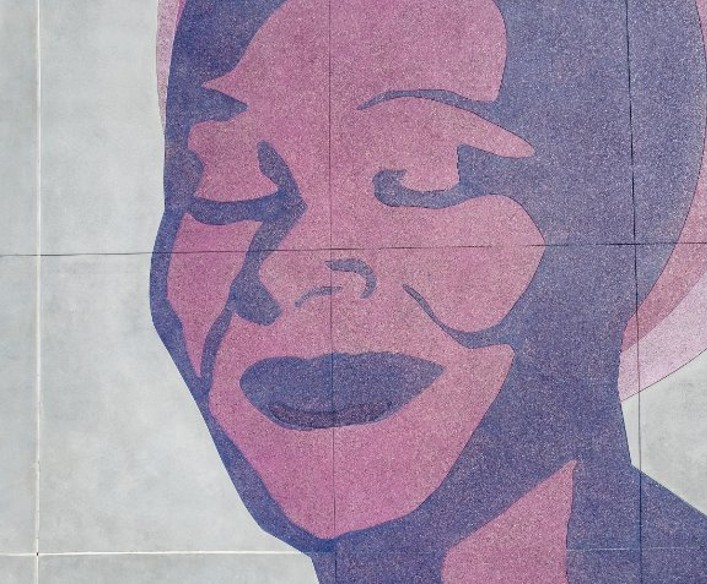2024 DCC Award Winner
900 Innes India Basin Park, T.B. Penick & Sons, San Diego, CA
First Place: Concrete Artistry, Over 5,000 SF
n 2014, the San Francisco Recreation and Park Department (SFRPD) acquired the 900 Innes property at India Basin in San Francisco’s Bay View Hunters Point (BVHP) neighborhood. With its scenic views, waterfront access, and rich natural resources, this site stands as the Department’s only San Francisco Bay-front property. In collaboration with the BVHP community, the Trust for Public Land, the San Francisco Parks Alliance, and the A. Philip Randolph Institute, SFRPD plans to transform this post-industrial brownfield into a 21st-century legacy park. This project emphasizes habitat and wetland restoration, public access, resilience to sea level rise, social equity, and waterfront recreation.
The development plan integrates the existing India Basin Shoreline Park area with the 900 Innes property, creating a unified 10-acre waterfront park that bridges a critical gap in the San Francisco Bay Trail. The project will unfold in two phases, starting with 900 Innes, followed by the rest of the India Basin Shoreline Park.
The goals for the 900 Innes project included creating a highly visible artwork on the pier to establish a destination point and attract visitors to the waterfront. To achieve this, the San Francisco Arts Commission (SFAC) held a competition, shortlisting four local artists and giving them two months to develop site-specific works for the new pier and park. The selection committee was composed of members from the community, design professionals, and a representative from Recs and Park SF.
We had the pleasure of assisting the winning artist, Raylene Gorum, in bringing her artistic vision to life using the Lithocrete system. We provided her with samples for the competition submission, and after her selection, we collaborated with her, the architectural and engineering team, and other stakeholders to further develop the artistic and technical details of her piece, titled "Lady Bayview." According to Raylene Gorum “Lady Bayview is an image of a female guardian figure whose hands encircle a glittering, circular universe. She is dressed in a swarm of shifting wind barbs and ships that describe the site’s layered history of innovation, perseverance, and community. The figure is intended as a talisman that reflects the community’s history and the legacy of the Bayview Five, a group of strong female African-American leaders in the community who successfully advocated for better housing, health and labor issues, a local theater and more.”
To create the design for Lady Bayview’s head, face, and hand, we poured Lithocrete embedded with a blend of ¼-inch lavender and purple colored glass, accented with red glass highlights. We then saw-cut and stained the pattern using custom water-based stains we made to match Raylene’s chosen Pantone colors. For the sparkling universe, we poured Lithocrete seeded with fine crushed mirror glass and stained this area with a custom water-based blue stain, achieving a dazzling effect. On the rest of the pier, we poured Lithocrete seeded with fine crushed mirror glass, and we sand blasted and stained the wind barbs and ships. In total, we poured 13,580 SF of Lithocrete and sandblasted and stained 157 wind barbs and 15 ships.
The project faced multiple challenges, particularly with the layout and formwork for the head and hands. Using a paper template proved difficult due to the wind, making it challenging to position without tearing. Once the head and hands were laid out, we had to form them using Masonite and siding board to accommodate their intricate contours. On cold days, we had to use accelerators in the concrete mix & strong winds complicated the finishing process, requiring finishing aids. Water control was also a challenge; we had to block the edge of the pier with sandbags and plastic, along with using Gelmaxx, to prevent contaminants from entering the water. Lastly, staining the ships presented a significant challenge, requiring meticulous attention to detail, especially when hand staining the white portions of the ships.

